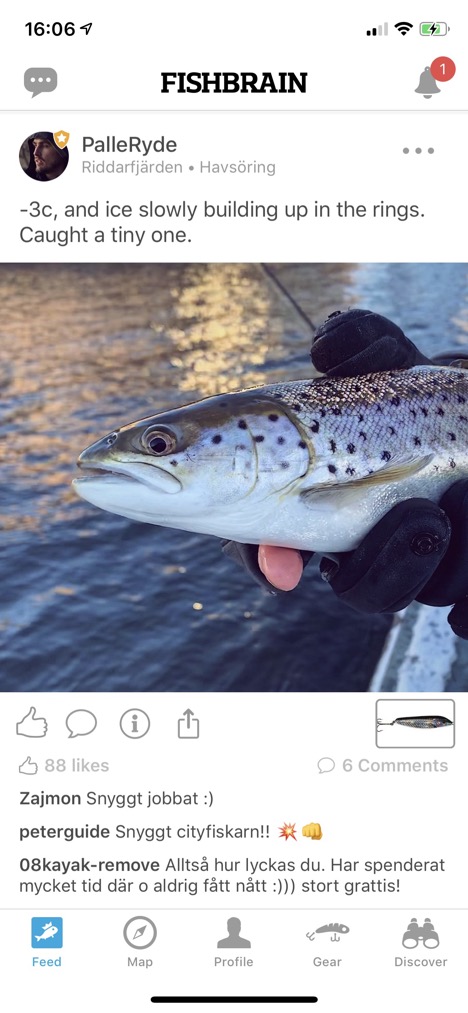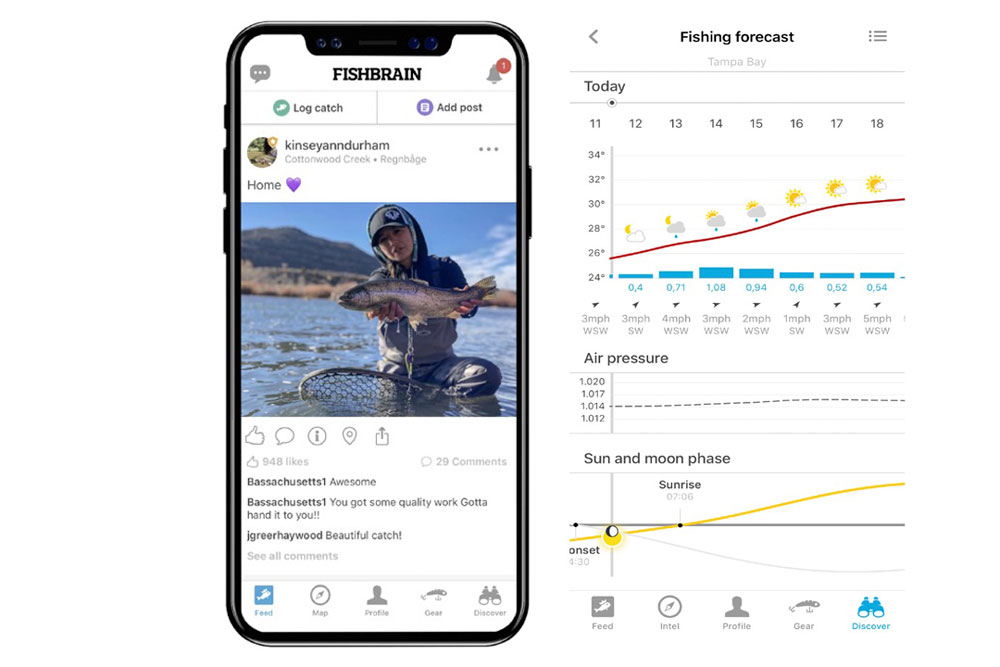While things weren’t looking promising for hunting in the 2016 National Survey of Fishing, Hunting, and Wildlife-Associated Recreation, the same report revealed fishing recruitment efforts were enjoying far more success. From 2011 to 2016, fishing participation grew from 33.1 million anglers to 35.8 million in 2016—an eight percent increase. Total angler expenditures also rose 2 percent, from $45 billion to $46.1 billion, during this time.
It’s hard to deny fishing is one of the most popular outdoor activities in existence. Social media users actively post and brag about their fishing catches on social media platforms. On Instagram, for instance, the fishing hashtag has been used over 25 million times.
Although the fishing industry’s future is very promising, could it use a boost from social media platforms? Indeed, technology can certainly help to bring more anglers into the fold.
Meet the Fishbrain App— created by the world’s most popular sportfishing mobile-app and social media company in Stockholm, Sweden.
Fishbrain was established in 2010 by Johan Attby, an avid fly angler and outdoor enthusiast who serves as the company’s chief executive officer. He’s hoping to change the way people fish and how anglers connect in an increasingly digital age. Cabela’s noted it was one of best apps for anglers to download on their mobile phones.
Attby recently spoke to Sporting Classics Daily on his company’s goals for luring more people into sportfishing.

Marrying Tech with Fishing
Johan’s desire to create Fishbrain, a vertical social network catered to sportfishing, was rooted in improving online conversations about fishing.
“When it comes to the social aspect,” said Attby, “I think it’s super important that users are having visuals that they want to share. And fishing is all about bragging.”
Social media users, he said, would rather brag in a peer group than a friend group. He suggested users get more useful feedback in a peer group.
Too many platforms, he added, just serve ads to people, absorb that information, and then turn it back to data. Crowdsourcing data, he believes, is far more effective.
“If you can crowdsource a lot of this catch information,” he said, “you can collect and actually give users a forecast on where to go fishing, when to go fishing, and tips such as ‘here are the ten most effective lures for fishing for trout in Lake Tahoe, for example.’”
Though tech is typically seen as a detriment to fishing, given recent social media breaches and its highly addictive nature, Attby believes the app can make the digital experience more meaningful and impactful.
“I think technology can actually help in a number of ways when it comes to fishing,” he said. “Not just in participation, but also when you look at the sustainability aspect of fishing. I’m a big believer that with tech and Fishbrain, we can do some good things there.”
The technology they employ is getting a lot of notice from companies like Google. Fishbrain partnered with them for their new Google Machine Learning Firebase SDK for image recognition to help users identity fish species and alert them about fishing regulations.
How to Use Fishbrain
Fishbrain users can set up a profile for free and log in their catches for over 50 different fish species. The app allows users to follow other anglers—whether they are friends or well-known outdoor personalities. It also gives people the choice to list their baits, lures, rods, reels, lines, and tackle along with their fishing catches, should they see fit.
When testing the app in preparation for this article, I found it very user-friendly and easy to navigate. They really make it easy to search for new species and locations to fish near home. Everything is in your SmartPhone.
Recently, the company announced their new feature, Fishbrain BiteTime™—considered the world’s most advanced fishing forecast tool. It provides data-driven insights on the best times for users to catch particular species. This new feature also accounts for climate data and trends, tailoring to how 50 plus different species of fish react to such conditions.

Interestly enough, 80% of catches on Fishbrain are catch-and-release. It boasts close to 5 million active users, with much of their base concentrated here in the United States. The age distribution is quite flat—peaking at users in their mid-30’s—but lots of kids and teenagers are regular consumers. Other countries where it’s popular include Sweden, Canada, UK, Australia, China, and Brazil.
Serving a Higher Purpose
Fishbrain not only seeks to enhance an angler’s social media user experience. Their goal is also to promote sustainable fishing practices that’ll carry to future generations.
That’s why they’ve established partnerships with conservation heavyweights like the U.S. Fish and Wildlife Service (USFWS), Florida Fish and Wildlife Conservation Commission (FWC), and Recreational Boating and Fishing Foundation (RBFF).
Through their work with USFWS, the company has partnered with the agency to use crowd-sourced data generated by app users to “assist the Service, states, conservationist groups and academics better understand, track and conserve imperiled wildlife.”
Similarly, Fishbrain has worked with FWC by using machine learning recognition technology to identify non-native freshwater species in Florida waters.
For their collaboration with RBFF, the company is assisting them to make fishing more accessible by integrating new fishing intelligence features onto their websites. They also hope to assist in their 60 in 60 campaign, which launched in 2016 to increase fishing participation to 60 total million anglers in 60 months by December 31, 2021. They also hope to assist RBFF with luring in more women, young people, and Hispanic fishing participants, as well.
They’ve been approached by researchers in the U.S., United Kingdom, Sweden, and Denmark, because their database of catches is among the world’s largest.
Attby said despite reluctance from certain parents to allow their kids to be hooked on technology, he believes Fishbrain can help activate kids outdoors and make it more fun.
“It’s so important to augment the outdoor activity on top and have a digital experience on top of that,” said Attby.
For readers with kids or those interested in the intersection of angling and technology, Fishbrain is worth considering. It’s not just another fishing app—it’s a vehicle from which conservation, sustainable fishing practices, and meaningful online exchanges can spring about.
If you want to be socially engaged in positive environment, it’s a great avenue to escape the noise found on popular social media websites or to help supplement your digital experience.
The Fishbrain mobile application is free for anglers to download on iTunes and Google Play. Premium features can be unlocked by paying $5.99. Follow them on Facebook, Instagram, and Twitter. To learn more about the app, visit www.fishbrain.com.

